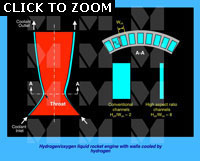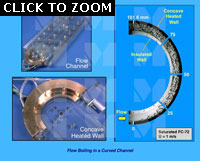Applications: Rocket Engine Cooling
 The walls of thrust chambers in modern liquid rocket engines encounter very high pressures and temperatures. In hydrogen/oxygen liquid rocket engines, the walls are cooled by hydrogen flowing at high flow rate through rectangular micro-channels. Wall cooling effectiveness is of paramount importance to the thrust chamber’s life, which can be nearly doubled if wall temperature is reduced by 50-100°C.
The walls of thrust chambers in modern liquid rocket engines encounter very high pressures and temperatures. In hydrogen/oxygen liquid rocket engines, the walls are cooled by hydrogen flowing at high flow rate through rectangular micro-channels. Wall cooling effectiveness is of paramount importance to the thrust chamber’s life, which can be nearly doubled if wall temperature is reduced by 50-100°C.
High cooling performance can be achieved by using a large number of closely spaced thin walls, provided flow in the channels is not severely restricted. A high channel height-to-width ratio both enables maximum utilization of the wall’s fin effect and helps prevent high pressure drop in the cooling channels.
 Depending on type of coolant and operating conditions of the rocket engine, flow boiling may or may not be desired. Flow boiling does offer the advantage of greatly enhancing cooling performance and reducing wall temperature. However, critical heat flux (CHF) inside the cooling channel is a primary concern and must be ascertained and prevented. Flow boiling CHF in this application is complicated by the channel’s rectangular shape, high aspect ratio and, most importantly, curvature.
Depending on type of coolant and operating conditions of the rocket engine, flow boiling may or may not be desired. Flow boiling does offer the advantage of greatly enhancing cooling performance and reducing wall temperature. However, critical heat flux (CHF) inside the cooling channel is a primary concern and must be ascertained and prevented. Flow boiling CHF in this application is complicated by the channel’s rectangular shape, high aspect ratio and, most importantly, curvature.
Curvature is known to enhance flow-boiling CHF from concave heated walls. Mudawar’s team performed photomicrographic studies of vapor coalescence along the concave heated wall of a rectangular channel. These experiments showed centrifugal force pulls vapor inwards (away from the heated wall) and push liquid outwards (towards the heated wall), which serves to prevent vapor blanketing especially near the channel inlet. Farther downstream, vapor is removed from the concave wall, fragmented, and distributed throughout the cooler bulk flow, where it is better able to utilize the bulk subcooling. CHF is enhanced by up to 60% for a centrifugal force equivalent to 315 times Earth gravity.
